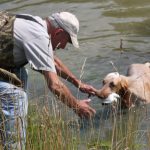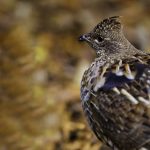West Nile Virus’s Effects on Grouse and Woodcock in the Lake States
By Steve Smith
Question: What’s black and yellow. Goes, “Bang!” and you sleep on it? Answer: A school bus, a firecracker, and a bed.
When something bad happens, the chances are that there is more than one cause. And so it is with the last season’s lower-than-expected ruffed grouse numbers. Unfortunately, many are laying the blame on one cause: The West Nile virus, and ignoring the poor hatching conditions that existed across much of grouse range.
I think we can all agree that when it comes to hunting ruffed grouse, the Lake States of Minnesota, Wisconsin, and Michigan are the real leaders. The bird populations, the number of resident and visiting hunters, the hours spent in the covers – all those are accurate measurements of the interest for this great bird in a great part of the country.
But, there is a shadow over the area right now in the form of that West Nile virus, a malady carried by mosquitoes. And while the bird populations didn’t rise to the level that some states’ drumming counts would have predicted, it was a wet and often cold nesting season, the weather turning bad about the time chicks were being hatched. Heavy rains, especially across the Upper Peninsula of Michigan, did no favors to the young cohort that should have been in the coverts for us hunters come fall.
But, the greatest concern among many hunters is WNV, especially in light of the problems it is reportedly causing in Pennsylvania. So, to find out more about its effects on grouse, grouse dogs, and grouse hunters, we looked at information compiled by the DNRs of these Lake States. A caveat: right now, it’s safe to say that way more is unknown than is known about the disease’s effects. What follows is a press release put out by the three states in the spring.
Great Lakes states to collaborate on West Nile virus monitoring in ruffed grouse
A region-wide effort to better understand West Nile virus in ruffed grouse is getting underway in Michigan, Minnesota, and Wisconsin.
“In the Great Lakes Region, West Nile virus has been found in a small number of grouse with no known population-level effects at this point,” said Charlotte Roy, grouse project leader with the Minnesota Department of Natural Resources. “Still, we want to let hunters know we’re in the first steps of monitoring the virus, and we’re planning to do some limited testing of birds this fall.”
In 2017, West Nile virus was identified in more ruffed grouse in the Great Lakes states than in the past. The virus has been present in Michigan, Minnesota, and Wisconsin for about 17 years.
West Nile virus has been documented in more than 250 species of birds; however, not all birds develop clinical disease from the virus. Corvids (including blue jays and crows) are very prone to illness and death from the virus, while other species may be less so or may not develop symptoms at all.
Last year, Michigan had 12 positive cases of West Nile virus in ruffed grouse. Prior to 2017, only one positive ruffed grouse had been found in Michigan, and that was in 2002. The virus was confirmed in one ruffed grouse in the early 2000s in Minnesota, and is yet to have been detected in a Wisconsin ruffed grouse.
West Nile virus in ruffed grouse has become a topic of concern because of a recent study in Pennsylvania reporting that the virus may have contributed to population declines in areas of lower-quality habitat or where habitat was scarce.
Michigan, Minnesota, and Wisconsin are in the early stages of planning to test samples from grouse this fall but at this point, there is no evidence that the virus is having a population-level impact in the Great Lakes region.
“By monitoring birds at a regional level, we will be able to gain a better understanding of this disease in ruffed grouse,” said Kelly Straka, State Wildlife Veterinarian with the Michigan Department of Natural Resources.
Ruffed grouse are hunted annually by around 300,000 hunters across the three states. Preliminary reports from 2017 hunters were mixed across the Great Lakes region. While the virus could impact brood survival of grouse, other factors such as cold, wet springs during nesting and hatching; drought conditions; or habitat decline can also affect birds seen and harvested.
Biologists in the region are optimistic that the great habitat for ruffed grouse in the Great Lakes states will help populations thrive despite the virus.
“We are looking to hunters and outdoor enthusiasts to help us in this endeavor,” said Mark Witecha, upland wildlife ecologist with the Wisconsin Department of Natural Resources. “This is an excellent example of agencies and organizations taking a proactive approach and working together to expand our knowledge about WNV and ruffed grouse.”
Recently, the Midwest Association of Fish and Wildlife Agencies Health Committee held their annual meeting in Traverse City, Michigan. WNV was one of the topics for state wildlife health leaders. Over 25 wildlife health professionals from 13 midwestern states and Canada were in attendance.
Individual agencies are currently reviewing ways they will be monitoring their grouse populations for WNV, and additional information will be shared when more details are determined.
Like humans, wild animals can be exposed to WNV and survive the exposure. Currently, there is no evidence of humans becoming infected by consuming properly cooked birds or by handling birds. Research has shown dogs can be infected but are very resistant to developing clinical signs of the disease and are considered an end host.
Michigan is the number one destination state for ruffed grouse and woodcock hunters, annually hosting thousands of non-resident hunters thanks to more than 10 million acres of public land and a 19-and-counting collection of GEMS, areas managed specifically for ruffed grouse and woodcock and open accessible only by foot.
According to Al Stewart, Wildlife Biologist and Upland Game Bird Specialist and Program Leader with the state’s DNR, setter man, and avid grouse and woodcock hunter, in North America, West Nile virus has been detected in over 300 species of dead birds. Michigan has diagnosed the disease in 60 species of birds and six species of mammals.
“In 2017, Michigan detected the highest number of West Nile virus positive birds and from the greatest number of counties since the virus entered the state in 2001. In 2002 a ruffed grouse was diagnosed with WNV, but we didn’t see another case of the disease until 2017. It is possible that West Nile virus could have contributed to the poor hunting season of 2017, but there were other factors, such as severe weather and the resultant loss of nests and chicks that likely had a greater impact on the population.”
When asked about the effects on woodcock, Stewart responded: “We diagnosed West Nile virus in a single woodcock from the Upper Peninsula in 2017. Since 2002, this is the only woodcock that we have received that was tested for the disease.
As far as a “cure?” Stewart said: “From the West Nile virus/mosquito standpoint, there is little that realistically can be done to prevent WNV in avian species. It is possible to spray to kill the mosquito vector [carrier] or drain areas to alter the breeding habitat of the mosquito, but on a large scale these practices are not possible.”
Now, some general Q & A of special interest to those of us who stumble our way through the autumn clearcuts.
I sent some questions of interest to wingshooters to Tom Cooley, Wildlife Pathologist, and Dr. Kelly Straka, Wildlife Veterinarian of the Michigan DNR.
Can dogs become infected with West Nile virus?
Research has shown that dogs can be infected with the West Nile virus, but they are very resistant to developing clinical signs of the disease. There are no studies that we know of that have shown that infection can occur via a mosquito bite or by consuming an infected bird. Even if they were infected via one of these routes, because dogs are resistant to the virus, they will not display clinical signs. Dogs are considered to be a dead-end host as they do not appear to be a source of further infection.
Is there any protection available for dogs against WNV?
There is not a West Nile virus vaccine that has been licensed for use in dogs. Because dogs are very resistant to the virus, a vaccination would not be warranted regardless.
What about humans?
The most likely route of a human exposure/infection would be via the bite of an infected mosquito. Transmission can also occur via blood transfusion, organ transplant, and from a mother to a child during pregnancy, delivery, and breast feeding. Most human infections are asymptomatic (80 percent), although one in five individuals may develop moderate symptoms such as a fever, headache, body aches, joint pain, vomiting, and diarrhea, and 1 in 150 may develop serious symptoms such as an encephalitis (inflammation of the brain) or meningitis (inflammation of the membrane surrounding the brain and the spinal cord).
Even though West Nile virus cannot be spread by handling a dead infected grouse, it is recommended to wear rubber gloves when cleaning any harvested game. Infection with West Nile virus cannot occur by [eating] a grouse that may have West Nile virus; but as a precaution, proper food safety guidelines indicate that avian species should be cooked to an internal temperature of 165 degrees. If a grouse is suspected of being sick, the recommendation would be to not consume it.
How can you tell if a grouse is infected?
Visually you may not be able to determine a West Nile virus positive bird. In Michigan, the ruffed grouse confirmed to be West Nile virus positive in 2017 varied in their physical condition from poor to very good. Grouse that were examined [in Michigan] had been found dead or were observed acting or flying in an abnormal manner at the time they were harvested.
How does WND affect grouse chick survival?
It would be assumed that a young bird would be more susceptible to a disease entity than an adult bird. There have been some research projects that have found that grouse chicks are very susceptible to the virus and can result in death. Research projects in grouse in this area of study have been limited.
What to Look For
Symptoms of WNV in Dogs
The chances of a dog becoming infected with WND are extremely rare, certainly more rare than a dog’s getting sick from a tick bite, and likely about as rare as getting nailed by a rattlesnake.
But some signs to look for should you suspect a problem: An infected dog will demonstrate overall weakness and muscle ache as though experiencing lameness; he can run a fever; and glands – lymph nodes — in the neck area can become swollen. The dog may develop a rash, which can be hard to see on dogs that have a heavy coat.
There is a danger – again, exceedingly rare — especially in older animals or those whose immune system has been weakened, that the virus can cause encephalitis, which is an inflammation of the brain and can be fatal unless treated. WNV is diagnosed by a blood test.
Symptoms of WNV in Humans
About 80 percent of humans infected with WNV have no symptoms; but if symptoms present, they do so as body aches, headache, joint pains, possibly a rash, vomiting, and diarrhea. However, symptoms can get worse and may result in disorientation, high fever, loss of vision, numbness in extremities, and stiffness in the neck region.
Though fewer than one percent of humans infected experience such symptoms, those over 60 years old are at the greatest risk, as are those with underlying afflictions such as cancer or diabetes. The best suggestion: If mosquitoes are present where you are hunting, wear clothing that covers exposed skin, and lather on the bug repellant.
According to the Centers for Disease Control, from 2004 to 2016, there were more than 640,000 cases of vector-borne diseases, the 2016 incidence being triple that of 2004. Seventy-seven percent of that increase is attributed to bites from mosquitoes and ticks.





